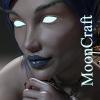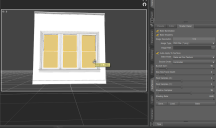Using a 2D image on my desktop on a Daz object
 MoonCraft3D
Posts: 379
MoonCraft3D
Posts: 379
I have a 2d image I would like to use in Daz. It is the image of a stain-glass window, that I would like to apply to a window model in Daz.
The 2D stain glass art is unique and does not come from Daz. I have it saved on my desktop. What steps do I take to add it to a window in Daz?
The desired result is that my 2d image become the stainglass of the window. I am aware there is no bump-map, for this purpose it just needs to be a flat image without bump, etc. It just needs to show up.



2019-11-09.png
1134 x 673 - 81K
Post edited by Chohole on


Comments
You need to get the UV template of the window in question or hide it's glass and insert a flat plane
and in Gimp or Photoshop etc create your texture maps to fit
How do I attach the 2d image to the flat plane?
under the surface tab in diffuse and any other maps if you create them
If you use a "Primitave plane", and your own image, you may also have to set the X and Y mapping and X and Y position, settings near the bottom of the "material", which you will be applying the image. ("Diffuse" {3DeLite} or "Base color" {Iray}, is near the top, you just click the [V] looking arrow, next to the wide blank box. That will ask you to locate an image to use. The bottom section is where you find the ability to scale and shift the tiling of the image, on the surface. It may default to being tiled a 100x or just 1x... You want it to be tiled only once, which may require a decimal-number or a large number, depending on how the UV for the plane is actually setup.)
It will not be too hard to set this up.
If you can find the windows material, you can try to replace that with your image, but it may not come out as desired. That is why there was mention of the UV-template or UV-Mapped image. That is just the image format they use, to place the image on the windows surface. But, that may not be a single image, and it may not even be UV-Mapped for an image at all. Thus, the suggestion to just hide the window-pane and replace it with the primative instead.
If you don't actually have to see through the window, and you are good with a paint program... You can do this in the paint program by rendering the windows without anything there, so they are 100% transparent and rendered with the ALPHA. You just add your window-image behind the window-frame rendering, on another image layer. But, if you are looking to cast light through it, or use reflections, then that idea is out the window, literally.
Attached are the indicated generic settings to place the image and align it, for IRAY, but Diffuse will be the one you want, for 3DeLite, on the primative plane.
You will also want to play with opacity or related settings, for windows... Reflection, Gloss, etc... You can easily use the stained-glass image to ALSO make a quick and dirty "transparency map", as a negative, if your bonding lead is dark. Thus, you can retain the solid lead parts, while the glass parts have various translucent parts. (White is solid, black is transparent, gray is translucent.) You may even be able to drop the same image into the bump-map or specular, for a dirty bonus there too.
With 6 planes, and using the offset and tiling settings, you can easily fill those glass sheets with the desired look you want. (You only need to do it for the top and the bottom, of one window. Then just duplicate the other four segments.) You may not even have to totally hide the glass, if you put the stained glass behind it, or in front of it, just a bit... or inside it, since most glass windows have thickness.